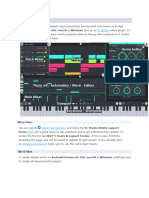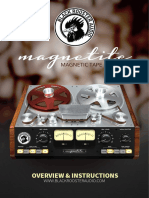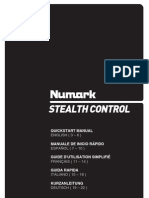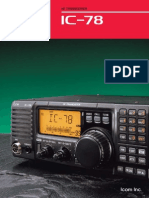Emulator Brochure
Emulator Brochure
Uploaded by
nahuelitsnCopyright:
Available Formats
Emulator Brochure
Emulator Brochure
Uploaded by
nahuelitsnOriginal Description:
Copyright
Available Formats
Share this document
Did you find this document useful?
Is this content inappropriate?
Copyright:
Available Formats
Emulator Brochure
Emulator Brochure
Uploaded by
nahuelitsnCopyright:
Available Formats
Imagine being able to play any sound
Introducing the Emulator polyphonic
The E-mu Systems Emulator, quite literally, puts the world
at your fingertips. With the Emulator, the entire spectrum of
sound is yours to control. You can play the sound of any
musical instrument - not just a synthesized simulation, but the
actual sound. You can play the sounds of voices, of nature, of
machines, of animals, of anything. All from a compact,
portable instrument that is incredibly simple to use and priced
within the budget of most serious musicians.
A digital instrument designed for the artist.
The Emulator is a computer-controlled instrument that can
record any sound into its digital memory and then allow you
to play that sound at any pitch over the range of its keyboard with up to eight note polyphonic capability.
Simply connect a microphone to record any live, sound, or
plug into the line level input to capture a sound from a
record or tape (or from another synthesizer). In either case
you just set the level, press the sample button, and in seconds
the sound is digitized, stored in memory, and available to be
played polyphonically on the keyboard. No longer will you
have to spend hours on tedious trial-and-error programming
only to find that your synthesizer is simply incapable of
producing the sound you need. If you can hear it, you can
play it on the Emulator.
With the Emulator, a new world of possibilities is opened up
to the artist dealing with music and sound. For the composer,
anything that makes sound becomes a potential instrument,
playable by any keyboardist, from parts written in standard
music notation. For the performer there is on-stage control of
sounds and effects previously available only in the studio. For
the sound effects designer there is the ability to create
complex tracks for film and broadcast in a fraction of the time
required by traditional tape splicing techniques.
Realtime control over any sound.
Despite its simplicity and ease of use, the Emulator provides
sophisticated live performance control. Its split keyboard
allows two independent sounds to be played simultaneously
(or you can record the same sound on both sections of the
keyboard for a full four octave range).
you can hear polyphonically.
digital keyboard instrument.
With our new multi-sample software, eight individual
samples can be recorded at half octave intervals across the
keyboard, resulting in more natural reproduction resonant
sounds plus the ability to have eight separate sounds available
on the keyboard at one time.
The performance controls allow the addition of vibrato to
any sound, with modulation depth controlled by a standard
mod wheel or foot pedal. A second wheel allows pitch
bending of musical notes and chords, and the creation of
novel effects with nonmusical sounds.
Additional controls allow you to sustain any sound indefinitely - regardless of its original length - by defining a loop
within the sound, which is repeated as long as a key is held
down. A footswitch selectable doubling mode makes it
possible to play on one half of the keyboard and have what
you play automatically doubled by the sound on the other
half.
Create a permanent sound library.
With the Emulators built-in floppy disk drive you can store
sounds on convenient mini-diskettes for later recall. Sounds
can be reloaded from a diskette in a matter of seconds and, in
a performance situation, you can even load a new sound into
one half of the keyboard while continuing to play on the
other.
Polyphonic digital sequencer.
The Emulator includes as standard a powerful polyphonic
sequencer. The Emulator sequencer will remember what you
play on the keyboard and play it back over a wide range of
tempos. Complex musical compositions and sound effects
tracks may be built up in a manner analogous overdubbing on
a multi-track tape recorder. Completed sequences are stored
on diskettes along with sounds.
Hear it.
Nothing that we can tell you about the Emulator can
completely communicate its range of capabilities. If you have
ever imagined having control over a world of sound, request
an Emulator demonstration at your local E-mu Systems
dealer.
Then you wont have to imagine.
Controls
Sound storage
Get lower - loads a sound from disk into memory for control by the
lower section of the keyboard.
Get upper - as above, but for the upper section of the keyboard.
Save - stores both sounds currently in memory on a floppy diskette.
Swap - exchanges control of the sounds currently in memory. between
keyboard sections (i.e. upper to lower and lower to upper.
Output
Mix volume - controls the level of the mix output without affecting the
independent upper and lower outputs.
Keyboard
Dynamic allocation - toggles keyboard channel allocation between fixed
and dynamic modes.
Vibrato
Lower enable - applies vibrato to the sound currently con trolled by the
lower section of the keyboard.
Upper enable - as above, but for the upper section of the keyboard.
Rate - sets the vibrato speed.
Sustain
Lower set - allows the user to set or change the sustain loop of the sound
currently controlled by the lower section of the keyboard.
Upper set - as above, but for the upper section.
Truncate/Filter - selects the function of the sustain section sliders.
Start point - sets the point within the sound at which the sustain loop
begins, sets the truncation point, and sets the sequencer playback speed.
Loop length - sets the length of the sustain loop and the filter cutoff
point.
Fine tune
Tune lower - adjusts the tuning of the sound currently controlled by the
lower section of the keyboard.
Tune upper - as above, but for the upper section.
Input
Specifications
Computer
Configuration - four and eight voice versions.
Sample length - two seconds per sound.
Input signal bandwidth - 20Hz 10kHz 3dB.
Playback frequency range - 10Hz-20kHz.
Data encoding - mu-255 companding law.
Signal to quantization error - 72dB
Pitch bend range - 2 semitones.
Fine tune range - 1 semitone.
Power requirements - 115v/230v; 60Hz/50Hz; 200W max.
Keyboard
Range - four octave / 49 key, C to C.
Split - between B1 and C2.
Sound storage
Medium 5 floppy diskettes, soft sectored, factory formatted.
Storage capacity - two sounds per diskette.
Inputs (2)
Input 1 - 600 ohm (Cannon connector).
Input 2 - 10k ohm ( phone connector).
Outputs (6)
Lower section - line level 600 ohm
(Cannon and phone connector).
Upper section - as above.
Mix - as above, with front panel attenuator.
Standard accessories
Vibrato depth pedal
Release mode footswitch
Doubling mode footswitch
10 diskettes
Software options
Users multi-sample - allows recording of eight individual samples at
half octave intervals across the keyboard.
Personal computer interface - allows an external computer to control
the Emulator.
Attenuator - adjusts the level of the signal to be sampled.
Level set - sets the gain of the internal preamp.
Overload LED - lights to indicate input signal overload.
Sample - sets automatic sample threshold level and initiates the sampling Hardware options
process.
Analog interface - provides for control of the Emulator by external
control voltages and gates.
Sequencer
RS-232 serial interface - required with the analog interface and the
Get sequence - loads a sequence from disk into sequencer memory
personal computer interface.
Sequence #1 - selects sequence bin #1.
Road case - foam lined fitted travel case.
Sequence #2 - selects sequence bin #2.
Store - initiates sequence recording and overdubbing.
Dimensions
Recall - initiates sequence playback.
Length - 37.5
Stop - terminates sequence playback.
Depth - 15
A - selects special function prefix A.
Height - 8
B - selects special function prefix B.
Weight - 75 lbs.
Wheels
Pitch bend - allows realtime pitch change of upper and lower sounds.
Mod - adjusts modulation depth for sounds with vibrato enabled.
Foot controls
Vibrato depth pedal - duplicates the function of the Mod wheel.
Release footswitch - causes the entire recorded sample to be played,
regardless of when a key is released.
Doubling mode footswitch - enables automatic keyboard doubling.
Specifications subject to change without notice,
E-mu Systems, Inc.
2815 Chanticleer, Santa Cruz, CA 95062
(408) 476-4424
You might also like
- Hark The Herald Angels Sing - King Of Heaven GTRDocument2 pagesHark The Herald Angels Sing - King Of Heaven GTRDavidHunterNo ratings yet
- Dxi 450 Wiring Diagrams Renault Premium PDFDocument223 pagesDxi 450 Wiring Diagrams Renault Premium PDFvaleriy98% (41)
- FL Studio Producer Edition 11.0.4 Incl Plugins Bundle R2R (ChingLiu)Document3 pagesFL Studio Producer Edition 11.0.4 Incl Plugins Bundle R2R (ChingLiu)Alexandru Gabriel TeodorNo ratings yet
- Where Is My Mind ?: Surfer RosaDocument3 pagesWhere Is My Mind ?: Surfer RosaLanda100% (3)
- Digital Keyboards Synergy ManualDocument74 pagesDigital Keyboards Synergy ManualThe LyonNo ratings yet
- FL Studio PDFDocument12 pagesFL Studio PDFJonathan RojasNo ratings yet
- Stereo Tool 7.83 - HelpDocument90 pagesStereo Tool 7.83 - HelpKirakirakirakiraNo ratings yet
- Pro Tools For Breakfast: Get Started Guide For The Most Used Software In Recording Studios: Stefano Tumiati, #2From EverandPro Tools For Breakfast: Get Started Guide For The Most Used Software In Recording Studios: Stefano Tumiati, #2No ratings yet
- Music Theory Grade 1: Based On The ABRSM SyllabusDocument20 pagesMusic Theory Grade 1: Based On The ABRSM Syllabusfschuil100% (1)
- Millimeter-Wave Technology Assignment II (10×1 + 5×2) : Imaginary RealDocument4 pagesMillimeter-Wave Technology Assignment II (10×1 + 5×2) : Imaginary Realgiri ssNo ratings yet
- 8DIO Hybrid Synphony EXP User ManualDocument24 pages8DIO Hybrid Synphony EXP User ManualsamNo ratings yet
- Emu Command Station xl7 mp7 DataDocument4 pagesEmu Command Station xl7 mp7 DatakalpkiavataraNo ratings yet
- 8DIO The New Ambient Guitar User Manual PDFDocument21 pages8DIO The New Ambient Guitar User Manual PDFcheungwingnok100% (1)
- FL Studio MobileDocument5 pagesFL Studio Mobileantonytwo60No ratings yet
- Cymatics Keys ManualDocument5 pagesCymatics Keys ManualGousto Mix OfficialNo ratings yet
- AIR Music Tech - Velvet v2 - User GuideDocument23 pagesAIR Music Tech - Velvet v2 - User GuideDimitri PetrenkoNo ratings yet
- Straight Ahead Jazz Horns ManualDocument15 pagesStraight Ahead Jazz Horns ManualMikeMoralesNo ratings yet
- String Quartet by Spitfire AudioDocument9 pagesString Quartet by Spitfire Audio이영찬No ratings yet
- Magnetite PDFDocument5 pagesMagnetite PDFWalterNo ratings yet
- Concert MateDocument40 pagesConcert MateBruce LeeNo ratings yet
- Soniccouture Thunder Drum User GuideDocument15 pagesSoniccouture Thunder Drum User Guideenigmatic_redroseNo ratings yet
- 8dio The New Basstard User ManualDocument21 pages8dio The New Basstard User ManualJack BrownNo ratings yet
- EG70 Virtual Yamaha PianoDocument7 pagesEG70 Virtual Yamaha PianospindolaNo ratings yet
- ALIVE-The EASIEST Way To Create SoundfontsDocument6 pagesALIVE-The EASIEST Way To Create SoundfontsRamon PazNo ratings yet
- ElectriKeys Virtual Vintage Electric Pianos VST VST3 Audio Unit EXS24 & KONTAKT: Fender Rhodes MkI and Suitcase 73, Wurlitzer 200A and 210, Hohner Clavinet D6, Pianet N, Yamaha CP-70, RMI Electra-Piano, Korg Dyno PianoDocument20 pagesElectriKeys Virtual Vintage Electric Pianos VST VST3 Audio Unit EXS24 & KONTAKT: Fender Rhodes MkI and Suitcase 73, Wurlitzer 200A and 210, Hohner Clavinet D6, Pianet N, Yamaha CP-70, RMI Electra-Piano, Korg Dyno PianoSyntheway Virtual Musical InstrumentsNo ratings yet
- PlugAndMix PRO-Series ManualDocument8 pagesPlugAndMix PRO-Series ManualMaximiliano LaynezNo ratings yet
- 8dio The New 1928 Piano - User ManualDocument19 pages8dio The New 1928 Piano - User Manualfreshjive.swagNo ratings yet
- Circuit Historial ActualizacionesDocument5 pagesCircuit Historial ActualizacionesMolomocoNo ratings yet
- AudioThing Outer SpaceDocument10 pagesAudioThing Outer SpaceSamuel SacherNo ratings yet
- Travel Light, Play Heavy: 01520 - Junodi - Product Sheet - Indd 1 6/11/09 2:10 PMDocument2 pagesTravel Light, Play Heavy: 01520 - Junodi - Product Sheet - Indd 1 6/11/09 2:10 PMNeil MayorNo ratings yet
- Endlesss Studio User Guide 1.3.0 (06-10)Document5 pagesEndlesss Studio User Guide 1.3.0 (06-10)vstfreepluginsNo ratings yet
- By The End of This Lecture Students Will Have Learned The FollowingDocument26 pagesBy The End of This Lecture Students Will Have Learned The FollowingRana WahabNo ratings yet
- FLStudio TutorialDocument4 pagesFLStudio TutorialMorteza ZargarNo ratings yet
- 8dio The New Glass Marimba User ManualDocument21 pages8dio The New Glass Marimba User Manualalfeus.adityaNo ratings yet
- Opus8 ManualDocument8 pagesOpus8 ManualBruno AntônioNo ratings yet
- Alesis Performance Pad Pro ManualDocument44 pagesAlesis Performance Pad Pro ManualGerbenHupNo ratings yet
- 2500 DataDocument4 pages2500 DataRudy PizzutiNo ratings yet
- Using A Mixer With A DAW by Ethan WinerDocument10 pagesUsing A Mixer With A DAW by Ethan WinerCarbon TheElementNo ratings yet
- web.archive.org-Ambiophonics PCMAC DIYDocument11 pagesweb.archive.org-Ambiophonics PCMAC DIYjahen79817No ratings yet
- User's Manual: Machine ReferenceDocument74 pagesUser's Manual: Machine ReferenceAngel JiménezNo ratings yet
- DSP2 ManualENDocument11 pagesDSP2 ManualENFILE OFFICENo ratings yet
- Outer Space: User GuideDocument8 pagesOuter Space: User GuideEsteban TorresNo ratings yet
- User Manual / Century Try PackDocument20 pagesUser Manual / Century Try PackManu MathewNo ratings yet
- AbakosVST Manual PDFDocument15 pagesAbakosVST Manual PDFPsicopathaDaEmusicNo ratings yet
- Overview & InstructionsDocument4 pagesOverview & InstructionsfranciscoNo ratings yet
- 3870 G-70 Bro 72Document4 pages3870 G-70 Bro 72junodiNo ratings yet
- TimeDrops ManualDocument7 pagesTimeDrops ManualJavi Gimeno-BayonNo ratings yet
- VN-3100PC - Frequently Asked QuestionsDocument5 pagesVN-3100PC - Frequently Asked QuestionscockybundooNo ratings yet
- AudacityDocument5 pagesAudacityfgtextNo ratings yet
- CASIODocument9 pagesCASIOThomas GeorgeNo ratings yet
- Akkordica Virtual Accordion, Concertina, Bandoneon, Harmonica and Melodica VST VST3 Audio Unit Plugins Plus EXS24 KONTAKT Sample LibrariesDocument19 pagesAkkordica Virtual Accordion, Concertina, Bandoneon, Harmonica and Melodica VST VST3 Audio Unit Plugins Plus EXS24 KONTAKT Sample LibrariesSyntheway Virtual Musical Instruments100% (1)
- Bassment ManualDocument11 pagesBassment Manualleo pugNo ratings yet
- Audacity - HandoutsDocument3 pagesAudacity - HandoutsCrystal NathalieNo ratings yet
- Vienna Soundfont StudioDocument8 pagesVienna Soundfont Studiodervisis1No ratings yet
- Free Amp SE Manual: Fretted Synth AudioDocument8 pagesFree Amp SE Manual: Fretted Synth AudioAntonio Arias GonzalezNo ratings yet
- SR 88Document7 pagesSR 88Hector GonzalezNo ratings yet
- Soundiron - Elysium HarpDocument22 pagesSoundiron - Elysium HarpgarthogNo ratings yet
- 8dio Free You - User ManualDocument19 pages8dio Free You - User ManualAcidbassNo ratings yet
- 8dio Supercluster - User ManualDocument18 pages8dio Supercluster - User Manualalfeus.adityaNo ratings yet
- Pearl Concert Grand DocumentationDocument10 pagesPearl Concert Grand DocumentationGuillermo AccilioNo ratings yet
- 2488 Home Guide - LastDocument50 pages2488 Home Guide - LastJohn WittenbelNo ratings yet
- Stealth Control Manual enDocument24 pagesStealth Control Manual enalexandre1980763No ratings yet
- How A Mixing Board WorksDocument5 pagesHow A Mixing Board WorksNiko PriestNo ratings yet
- Audiority TheModularPiano ManualDocument17 pagesAudiority TheModularPiano ManualJorge VillafañaNo ratings yet
- Coronavirus Whitney Webb 1Document25 pagesCoronavirus Whitney Webb 1martinscodeller100% (2)
- D.O and I.O ActivityDocument2 pagesD.O and I.O ActivityyzmszccqgzNo ratings yet
- Libertango Piano Soloaccordion SoloDocument7 pagesLibertango Piano Soloaccordion SoloАлександра ШмытькоNo ratings yet
- Deployment, Security PlanDocument7 pagesDeployment, Security PlanBongabong Mps Ormin PpoNo ratings yet
- UniFi STAFF PackageDocument27 pagesUniFi STAFF PackageSam FarizoNo ratings yet
- The Ultimate Guide To The Rolling Stones: Online Database by Felix AeppliDocument85 pagesThe Ultimate Guide To The Rolling Stones: Online Database by Felix Aepplifranckf97No ratings yet
- Kac 748Document11 pagesKac 748Marcelo G HNo ratings yet
- Avr 1612 1622Document146 pagesAvr 1612 1622Ronald100% (1)
- JMS Transmitter Non-IsolatedDocument1 pageJMS Transmitter Non-IsolatedSriyonoNo ratings yet
- Lic Lab Model QuestionsDocument13 pagesLic Lab Model QuestionsbasheervpNo ratings yet
- Tech Tip Arpeggio Exercises AbejorroDocument5 pagesTech Tip Arpeggio Exercises AbejorrolegualguitaristNo ratings yet
- JMA-3300 Service ManualDocument238 pagesJMA-3300 Service ManualclaudioNo ratings yet
- Instrument Reference Chart v4Document2 pagesInstrument Reference Chart v4Rosie Chase100% (6)
- Why We Sing Chapter SamplerDocument29 pagesWhy We Sing Chapter SamplerAllen & UnwinNo ratings yet
- Jane Goodall NHDDocument8 pagesJane Goodall NHDapi-308643435No ratings yet
- Band Balance and Seating ChartsDocument8 pagesBand Balance and Seating Chartssaxgoldie100% (2)
- 9 E4010E-01 (NEO Training Manual 20jun)Document106 pages9 E4010E-01 (NEO Training Manual 20jun)JuanNo ratings yet
- Once Upon A Time-Clarinet in BBDocument2 pagesOnce Upon A Time-Clarinet in BBRoberto FioreNo ratings yet
- Oscar Wilde BiographyDocument16 pagesOscar Wilde BiographyEvelina TurdaNo ratings yet
- 17 1 17 1 10 20080131 PDFDocument7 pages17 1 17 1 10 20080131 PDFMæbēTh CuarterosNo ratings yet
- Rootless Chord Voicings - The Jazz Piano SiteDocument6 pagesRootless Chord Voicings - The Jazz Piano SiteMbolafab Rbj100% (1)
- Fast Fourier Transform (FFT) With MatlabDocument8 pagesFast Fourier Transform (FFT) With Matlababdessalem_tNo ratings yet
- IC 78 BrochureDocument4 pagesIC 78 BrochureRicardo Ortiz CoronadoNo ratings yet
- Oxford Team 3 TestsDocument30 pagesOxford Team 3 TestsИннаNo ratings yet
- Film GovindaDocument6 pagesFilm Govindaiwan rashanNo ratings yet

























































































